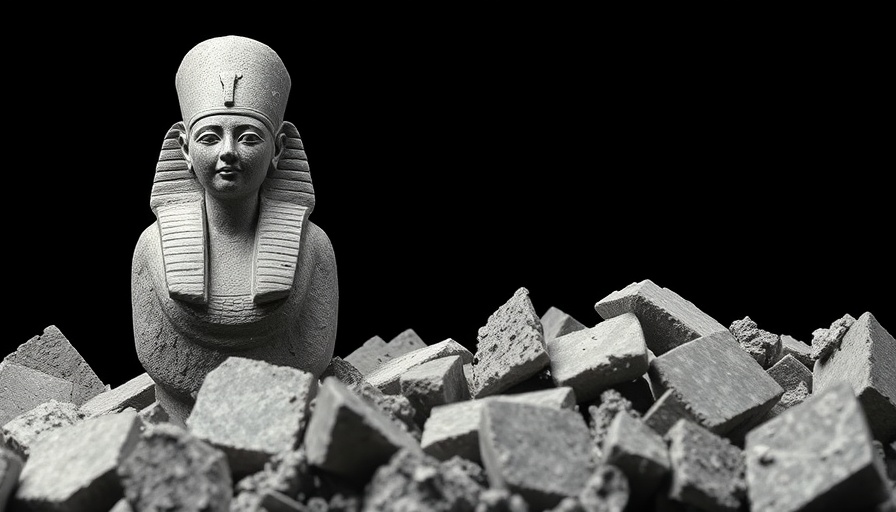
A New Perspective on Hatshepsut’s Statues
Hatshepsut stands as one of the most prominent and remarkable figures in ancient Egypt. Serving as a regent and ultimately as a pharaoh in her own right, her reign from 1478 to 1458 BCE is a fascinating chapter in Egypt's storied history. Following her death, many believed that her legacy was forcefully wiped from history by her nephew and successor Thutmose III, who was seen as spiteful enough to want to obliterate all traces of her rule. New research, however, sheds light on a more nuanced truth that merits a deeper examination of Hatshepsut’s ongoing legacy.
The Myth of Vengeful Destruction
The story of Hatshepsut's statues, many of which were found in pieces, has been long characterized as an act of vengeance against a notable female ruler. However, Jun Yi Wong, an Egyptologist at the University of Toronto, suggests that the narrative surrounding her statue's destruction might not be so straightforward. Instead of simply interpreting the physical damage as the product of Thutmose III's malice, Wong proposes that ritualistic practices aimed at "deactivating" a statue's power played a significant role in the condition of these artifacts. This theory challenges the idea that the destruction was solely politically motivated and opens up discussions around the cultural and ritualistic context of ancient Egypt.
Deactivation Rituals: A Cultural Context
In Wong's research published in the journal Antiquity, he emphasizes that damage to Hatshepsut's statues included breaks at key anatomical joints like necks and knees, indicating an intentional method to immobilize the statue's perceived power rather than malicious intent. In ancient Egyptian culture, significant monuments and images could be “deactivated” to nullify their power, a practice that was not unique to Hatshepsut’s representations. Male rulers, too, experienced similar treatments posthumously. This understanding nudges us towards a culturally specific interpretation rather than a purely political narrative.
Representation and Memory in Ancient Egypt
The implications of Wong's findings extend into wider cultural realms. While Hatshepsut might have faced political trials and tribulations, the nuances in how her images were treated suggest that her legacy was more complex than Shi was merely suppressed. Some remaining statues, though fragmented, still held intact features such as faces, leading Wong to hypothesize that a genuine respect for Hatshepsut's reign likely persisted even after her death. This points to a delicate balance between reverence and the political maneuvers that followed her demise.
Archaeological Insights and Historical Reconstruction
The excavation of Hatshepsut's statues from 1922 to 1928 revealed a trove of insights into Egypt’s rich past. The narrative shaped by early archaeologists like Herbert Winlock, who termed these remnants “maddening relics of Thutmose’s spite,” laid the groundwork for a skewed understanding of Hatshepsut's legacy. However, Wong's thorough analysis of early excavation notes and recovered images reveals a richness that contrasts sharply with the assumed despair of the artifacts. Considering that some statues were repurposed as building materials also reflects the ways in which history is not merely about erasure but rather transformation.
Future of Understanding Hatshepsut’s Legacy
The future of ancient Egyptian studies lies in a deeper respect for the complexities of figures like Hatshepsut. Deciphering her legacy requires a balanced approach that acknowledges the nuances of ritual significance, political landscape, and cultural preservation. As new archaeological methods and technologies emerge, coupled with fresh research perspectives, our understanding of such historical figures is poised for transformation. To genuinely appreciate Hatshepsut, we must resist the temptation to boil her story down to mere triumph or failure, brick or ruin — her legacy embodies a multitude of facets forged through time.
The Legacy of Hatshepsut: A Call to Reflect
In recognizing Hatshepsut’s multifaceted impact on ancient history, we embrace a narrative enriched by understanding rather than one dictated by political narratives. Rather than merely viewing her as a victim of destruction, this re-examination of her legacy opens a conversation on empowerment, the role of women in history, and the lingering power of monuments in shaping our perceptions.
 Add Row
Add Row  Add
Add 




Write A Comment